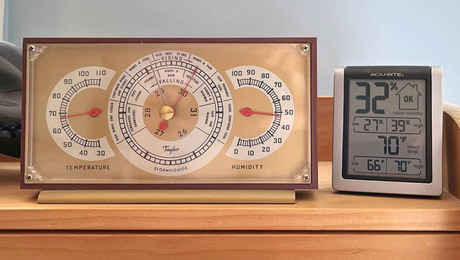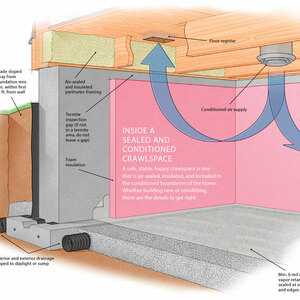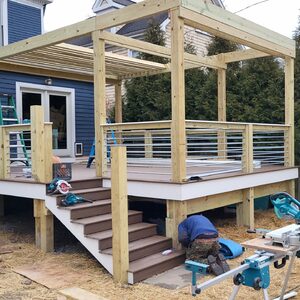I’ve always used a quality poly varnish (Mautz, Varathane) for floors with good results, but saw Waterlox highly recommended after a BT search.
Any recent users, who also have experience with linseed-based poly-urethanes, of Waterlox Tung-based finishes for floors?
Is Waterlox as good as their marketing literature claims?
Also, I’ve already sealed this particular project with one coat of Zinsser wax-free shellac. Would you recommend Waterlox applied over this shellac sealer?



















Replies
I have used waterlox in two homes we have lived in . It holds up well in heavy foot traffic, large dogs with long nails, moisture and dirt. The final coat used to be called gym floor finish, it is now called high gloss finish. The finish is easy to repair if damaged. Most polyurethane finishes are not easy to repair.
I like waterlox. They've been around for a long time, like 75 years. Same product. Say that about any of the fancy new finishes that get released and "improved" and discontinued about every other year. Waterlox is very happy on top of dewaxed shellac, which is what Sealcoat is. I've used a good few oil polys. No major complaints. You end up with a coating about 3 or 5 times as thick as waterlox. Waterlox is one of the few that recoats easily. No prep, just wipe on some more.
Thanks for your input, but a point of clarification:
"on top of dewaxed shellac, which is what Sealcoat is"
Are you saying that "Sealcoat" is a Waterlox product, or are you referring to the Zinsser dewazed shellac that I used (and really like)?
Whoops...you must be referring to the Zinsser, Waterlox calls thiers "Waterlox Original Sealer/Finish"
OK, so a follow-on question, will I get the same penetrating action after I've already got a coat of shellac
"Unique blend of tung oil and resin penetrates deeper and seals wood fibers beneath the surface."
Edited 7/12/2004 2:30 pm ET by johnnyd
Sealcoat is a dewaxed shellac. Works well and easier to find than dry shellac flakes. No, you probably won't get the same penetration of Waterlox or any finish when applied on top of a shellac coating. That has both good and bad points. On something that tends to blotch badly - pine or cherry - sealing with shellac can make the finish look more even. On maple or other woods when you want a more dramatic effect, waterlox can look better without the shellac underneath. Except for endgrain or cracks, you're only talking about a couple thousandths of an inch penetration anyway. The shellac has penetrated and will harden the surface a little, but it doesn't go maybe quite as deep as the oil would. Shellac is an excellent bonding agent and seals in natural oils that could otherwise interfere with oil finishes. Very important on wood like rosewood.
Waterlox is excellent. Easy to apply, and even easier to touch up. Don't worry, we can fix that later!
You seem to know a lot about wood and finishing wood: have you ever used those wood hardeners for rotted wood, but on good wood? I've used it on plywood edges--it seemed to help harden them and keep them more stable. Just wondered if there's a reason not to? Seems like I used some sort of finish over it, but don't remember what. Some finishes may not be compatable with whatever's in that wood hardener.
There are two sorts of wood hardener I know about. The single-part stuff like Minwax and the epoxies. I think there may be a polyester product too, but I have not used it. Minwax is basically a thin lacquer. I've used it with some success. Don't know how long it lasts, but it works for a couple years at least. It will take real punky wood and harden it to something like soft pine. The epoxy gets much harder. My impression is that the minwax soaks in deeper, but the epoxy is certainly stronger. Whether either one would be useful on sound solid wood is doubtful. They would not penetrate much. On plywood, probably yes. It would soak in a good distance on the endgrain plys. I don't think it would add much strength, but it would certainly seal it well. Either one will take a finish on top. I suspect that water-based poly could be a problem, but about everything else should work. I've used latex and oil paint on top without a problem.
So far as Waterlox, the installer's guide says no traffic on floors for a week. Its not printed on the can, but it will take marks unless you wait. You can walk around with socks, but no furniture or shoes on it for a week. I think the guide is on their website somewhere in PDF form.
Thanks for the reply. One more thing--ever hear of Hope's "Floor Revive"? Sounds too good to be true; supposed to refinish a floor without having to sand--just squeegee it on and it fills all scratches and makes it shiny and new. If it weren't so expensive, I'd get some just to play with. May get some anyway.
Just helped a guy I work for to refinish a floor. Problem was moving the piano. After we refinished the floor and put three coats of poly, lady reluctantly let us wait a week to move piano back in. We put pieces of Formica down under impossibly small (1/2" wide by maybe 3/4" brass wheels) and rolled it back in. But we hadn't done that when we moved it into the living room, so she wasn't too happy about the grooves it left in that floor! Some one had moved it before finishing the floor we refinished and they had filled the grooves with stain. I sanded the stain out, but to get the grooves out we would have had to take the floor down another eighth inch. She didn't like that either, but seemed to be resigned to it. There were slate steps leading into that room--had unsupported lip on front that was chipped. I would have tried to patch it with epoxy putty and supported it with decorative molding, but Marc told her there was no fix. He's probably right. My fix would have been hard to blend and may not have lasted.
If you've been reading the archives, then you've probably already read a post or two of mine on this subject, but just in case...
Waterlox takes seven days to fully cure. If it says this on the can, I never found it. The web site says it though.
I have limited experience, but enough to see a huge difference if traffic is kept off of it for the seven days.
Rich Beckman
Another day, another tool.
really need to let it dry much longer than the can says or the next coat will NOT stick but will seperate into streams and lay on top the floor there by looking ugly and causing u to resand ,
otherwise a good product.
but whats wrong with "regular quick (24 hr) dry poly?
.
Why look for a better way? That relates to the other current thread "Best tip ever on BT" This started with an archive search for "best floor varnish", which got me to the Waterlox web site, which sounded a little too good to be true. Not a good sign about a product.
Worse, when I called thier tech line to ask about going over shellac with Waterlox, the guy said:
"Well, we think we have the best sealer in the world and would never recommend a first coat of shellac, but now that you've already done that, I suppose it's OK..."
Another bad sign.
So it's back to BT to get the real low-down. I've been around long enough to know that bad sales/marketing can ruin an othewrwise good product, and I remain intrigued by the whole tung-oil/resin versus linseed oil based varnish thing and really like the repair without resand deal they (and ya'll) talk about. So keep the comments coming if you can.
Thanks for your input.
I got very good product support from waterlox 1 800 man.
i had tung oil on my floors - it was the worst possible floor finish - attracted dirt and water spotted - real bad in kitchen , also would not shine. Experst say buff it i say BS.
could not put poly over tung oil without sanding, so I used waterlox.
great shine, good sticking. expensive. not stocked locally in gallons (I am in a city of 400,000 people - that tells you the "market" uses something else.
had the streaking problem in two rooms.
the recoat spot patch areas w/o sanding claim is true but you can still see where you patched it.
I'm pursuing this for the same reason that all of a sudden after I became convinced that blown in cellulose is better than blown in FG, I couldn't find a cellulose applicator in a town of 100,000...had to go to a fringe area where one guy was doing it part time in addition to his building contracting. Got the same tired reasoning (from the FG contractors) that cellulose will "settle" and "it's just shredded newspaper"
It's hard to get the straight poop on any "new" or "alternate" product directly from who-ever is selling it or has a vested interest in applying it...even when it might be demonstrably better for an individual application.
This Waterlox stuff seems to list at just a few dollars more per gallon than premium varnish.
I used Waterlox...3 coats with a day between each. Has worked perfectly for 2 years now, I think. I like that it can be reapplied, and that the look is specifically not a varnish look. Also like that I could bumble along on my own without having the signs of an amateur varnish application, such as brush marks, drips, etc.
Thanks very much Cloud...that's what I wanted to hear.
Waterlox is a very traditional long oil varnish. The best of that breed probably. Exactly what product to use for what effect is not a simple choice. That's why there are at least 50 different varieties of finishes and hundreds of brands. Not a miracle product, but much more forgiving than many. I like it especially on furniture. Its pretty good for floors. I'd probably not use it for a commercial job, but its good for residential if you can deal with the drying time. It has a very nice look. Not milky, a nice amber tone. Thin. Compare to the difficulty of using some of the new professional coatings. Special sealers, mix the toxic catalyst, use it before it sets up. Specific time windows for recoating, constant stirring, very expensive. Cannot recoat without sanding. Durability? Sure, some of the new ones are better. Some get nasty white frosty patches after only a couple years. Just like nails and screws. Thousands of choices. You pick the one that seems right for the job. Its not the only finish I use.
So far as tung versus linseed and alkyd and urethanes and acrylics and a zillion others, you have optical and chemical and physical and cost issues. Gets complicated and depends on what sort of look you want. Depends on how the manufacturer processed the raw materials. Wide variations in ease of application. Could have a very long discussion on the subtle points. There is no single best choice.
So far as shellac, everything worthwhile sticks to dewaxed shellac. If it won't stick to shellac it probably won't stick to wood either.
"everything worthwhile sticks to dewaxed shellac"
I think that is only half the answer though....
Part of the sales pitch for the Waterlox is that it penetrates the wood to help harden it to resist water, staining, and damage. If the shellac slows or prevents the penetration of the Waterlox, it would decrease a portion of this strong point, so I would prefer using the waterlock itself for first sealcoat.
Welcome to the Taunton University of Knowledge FHB Campus at Breaktime. where ... Excellence is its own reward!
Yes, that is part of the sales pitch. They're about half right. Waterlox looks better when applied directly. That's an optical issue. Penetration is way overrated. You're talking thousandths of an inch at best. Apply a coat directly to something like maple or poplar face grain. Slice it up and look under a microscope. Probably no visible penetration depth. More on open pore woods or end grain, but still not a lot. To get any significant penetration coatings or dyes have to be applied under pressure. Coatings mostly just sit on the surface. A coat of shellac will also penetrate a bit on bare wood. So long as the coatings bond well to each other, I don't see a problem with a shellac wash coat. In fact, shellac has better water resistance than many varnishes. You wouldn't want a thick shellac layer usually since its more brittle. On some woods, there are very good reasons why you want the shellac. Pine. Turpentine comes from pine and a fair amount remains in the knots and pitchy spots. Turpentine is a powerful solvent and can migrate through most varnishes, including waterlox. Shellac is one of the very few things that acts as a barrier and bonds well to the wood and other coatings. Thats why you use a shellac primer on knots, regardless of whether the topcoat is latex or oil. Pine, teak, rosewood and other oily or resinous woods need the shellac. Other woods may benefit to reduce blotching. Some don't care at all, like oak.
As far as I know, shellac is the only finish that is a vapor barrier (other than some paints).
Shellac is pretty amazing stuff, considering that bugs make it. Chemists have been fooling around with synthetic coatings for a long time. Latex, acrylic, PVA, synthetic or modified oils, plus all the exotic stuff. The natural products still have not given up the fight. There are synthetics that work well, but given the cost and simplicity shellac is hard to beat.
While all you floor guys are here, I hope you don't mind if I slip in a related question. We are building a home and using 4" quartersawn white oak flooring. Our current home has quartersawn red oak. I love the flaking in the wood, and on our current house's floor, which has a clear stain/polyurethane, the wonderful effects in the wood are not real apparent. What can I do on the new house flooring to really bring out those medullary rays?
Several different things work. Different amounts of difficulty. You'll need to do some test strips to see which you like. The flakes absorb differently than the rest of the wood. Simplest thing is a light coat of oil. Tung, "boiled" linseed or waterlox. Wait until thoroughly cured (a week at the very least). Then topcoat with whatever oil varnish you choose. Waterbased is not a good choice here. Can be adhesion problems. This gives the most natural color.
Next is a dye. Water or oil-based. Alcohol dyes dry too fast. Use a color similar to the wood itself. A light application. Screen after the dye dries. This takes a light touch. You just want to screen enough to remove dye on the surface, but not remove where it has soaked in a little. This will double the contrast. If you pre-wet the wood with either mineral spirits or water (depending on which dye) it will give less contrast. Applying oil after a water-based dye works even better
Last choice is stain. Stains have both pigment and dye plus a binder. The pigment sticks in the pores and accents the grain. The dye does an overall tone plus capitalizes on the differences in absorption. Screen lightly. You can apply dye and pigment separately, but need to mix your own in this case. If you stain, the brand must be compatible with the topcoat.
I wouldn't use a buffer to do the screening. Goes too quick. Just a drywall sanding pole. Use the opposite sort of dye to whatever finish you choose. Water under oil and vice versa. That way the topcoat won't re-disolve the dye and even it out or color the topcoat.
vapor barrier?
could you spray the under side of floors over a crwal space to slow down water vapor going upinto hardwood floors above?
I don't know--I think it would be expensive and kind of messy, in a little crwl space over your head. I think the best way to stop vapor from crawl space is to put in polyethylene sheeting over the soil in the crawl space and lapping it. Others may have better ideas.
thanks but
ac ducts sweat
I don't know if you mentioned the overall construction or not in an earlier message.
But look at doing a "sealed crawlspace" or "conditoned crawlspace".
Varpor barrier on the soil and walls and insulate the inside of the foundation walls and NO VENTS to the outside.
Thanks for those points, right now we are putting down a wide pine floor that I had sealed on all sides first with shellac so it would slow the movemeent of moisture in and out of the wood and prevent cupping or curling and to keep any potential stains out of the wood grain untill we sand and do the final finish.
Welcome to the Taunton University of Knowledge FHB Campus at Breaktime. where ... Excellence is its own reward!
Good approach. That will keep it cleaner. The only time shellac may get in the way is when you stain or dye. Also, it isn't the greatest stuff to sand. It melts at a low temperature and clogs up belts.
Paul
I'm about to order within the next cpl of months about 1500 sq ft of Eastern White Pine....10-15" widths and not T&G.
I've got two companies courting me every other day.
the one I ordered 350 sq ft from for my LR thats finished (Carlisle) and another....Timberknee.(TK's shipping is less expensive)
the price difference for the same widths with shipping and the hand made nails is about $1800....Timberknee is the less expensive company but the product Carlisle sent me was excellent "except" for that Tung Oil they sold me.....neverrrrrrrrrrr again!!!!
Thank god I didnt do the whole house in it.
OMG...you should only hear all the explanations I'm getting from both companies about what the best floor is.
Seems Timberknee says.....they dont normally sell 10-15" planks because its so expensive.
Carlisle says that in order to get 10-15" boards the trees have to be about a hundred years old...nowwwwww.....Timberknee found 10-15" boards for me at a good price....oiy vey...oiy vey....lol
I'll send you an Email if ya want of both bids.
Hate buying something sight unseen.and the 8" sample TK is sending me is probably worthless.I do have an entire living room of Carlises flooring which is really nice cept for the friggin Tung shid.
I know Calisile spends LOTS of money on advertising (am I paying for that compared to TK)?
$1800 bucks is a "lot" of savings......what to do what to do....ugh
BE well
andyThe secret of Zen in two words is, "Not always so"!
http://CLIFFORDRENOVATIONS.COM
What's that work out to as a percentage?
or
it seems like a lot of difference, do they break down what is for nails, sealer, etc?
I get most stuff local up here. That way, I do get to see it first.
When I buy through a broker or order, I write up my own spec purchase order, especially with regards to antique heartwood or special items like this. I define the things that are important with regards to moisture content, growth rings, allowable knots etc. Then, if they accept the order, they are bond by the specs. When you buy retail, they say, "This is what it is, take it or leave it" because they are writing their own specs. When you get outside the standard lumber products, you get outside the standards for grading so they can do that.
Welcome to the Taunton University of Knowledge FHB Campus at Breaktime. where ... Excellence is its own reward!
Paul
After work today I'll send you an Email with the two bids.
I really dont think its right to post it here but none the less I do post the names of the companies in case others have personal experiances with them that may help us.
The growth rings on most of Carlisles flooring they sent me are "12" if I counted right...or better.
The knots were perfect for the look I wanted.
I like their product but an $1800 differance is a lot.
In the price from TK the nails were included.
As I said I'll send you their bids via Email.
I have no yards near here that sell this stuff that I can look at unfortunatly so I'm up against the wall in that respect.
I wrote an Email to the two companies yesterday asking how long the wood is dried and how its dried and the moisture content.
I spose when I get the answers in writing I'll be sure to have them put that in writing and tell them that I'm holding them to it.
But once again....Carlisles flooring I'm very happy with (not the stain or tung oil finish) yet I still wonder if they basically do it the same way and I'm paying for Carlisles advertising.
Anyway...thanks Paul and its an intersting trip as usual.
BE well bro
andyThe secret of Zen in two words is, "Not always so"!
http://CLIFFORDRENOVATIONS.COM
Wow. Thanks for the education.
Just a heads up...got 2 gallons of the "Original" and a gallon of high gloss. Goes on this weekend. I'll let you know how it turns out.
how long ya lettin' it dry for?
Id be interested in that.
Be floored
andyThe secret of Zen in two words is, "Not always so"!
http://CLIFFORDRENOVATIONS.COM
Well, here's the deal. This is primed/sealed with wax-free shellac, but even then the first coat mostly soaked in and was dry to the touch in about 7 hours. I put the second coat on 24 hours after the first coat was applied, when the surface was not tacky at all.
Of the two rooms, one has cross ventilation, the other just one window in the wall opposite the door. The one with cross ventilation dried a bit faster. The stuff is really sensitive to airflow.
The second coat (applied early yesterday morning) was still sticky last night at 8PM. Early this morning (about 6AM) I started the third coat, and I think it was just barely dry enough...I apply on my knees with a 4" china bristle so I have to support myself with my left hand, and some places were just a touch sticky. I could detect some brush drag along the walls and corners.
So we'll see how it looks tonight. I have enough left for a forth thin coat if necessary.
The stuff sure smells different from linseed-oil based poly. Kind of reminds me of the smell of going back to school in the fall...which makes sense because I think they use(d) this alot in schools. Easy enough for a janitor to apply and plenty of time to dry if done in the summer with no traffic.
Directions say wait at least a week before any furniture, rugs, or traffic.
Someone wrote in an earlier post that it was known as "gym floor finish" or something like that and mentioned it was used a lot in schools on gym floors. That smell, the smell of that stuff that kept dust down when the janitors swept, and, of course, the smell of vomit are so evocative of the school experience! ; )
I think you are pushing the time.
Took a long time - two weeks or more for fumes to go away- and my RH is less than 50%
Can't remember if I had the problem with adherence when putting on the 3rd coat but i think that was it.
let it dry
Yes, I'm pushing it, evidenced by the drag on the brush in the corners that got less air movement after 2nd coat.
But not nearly as bad as I pushed on Varathane Poly last summer. That turned into a gooey mess on application of 2nd coat after 4 -5 hours of dry time on a nice, dry June day. Eventually did not look to bad after drying and a third coat of semi-gloss.
johnnyd
Why didnt you use a lambs wool applicator???? Wouldnt that have been a whole lot easier,better and quicker, not to mention you could stand up as you applied it?
What was the reason for a 4" china bristle brush?
If thats what I'd have to use on about 14-1500 sq feet I may not be alive to finish it...lol.
Be floored
andy
The secret of Zen in two words is, "Not always so"!
http://CLIFFORDRENOVATIONS.COM
A lot of us here use china bristles to apply floor finish on our hands and knees. The lambswool will leave signs where it turns at corners etc, so you have a less than perfect smooth finish when it dries.
but around here, almost everyone has a boat - with some brightwork on deck, and takes pride in seeing a good finish. There are painters here who specailize in hulls, and can use a brush to give a finish to rival a spray job - not me, but I can do a smoother floor with a brush than with a lambswool.
For the record, I don't mind if a floor guy prefers to use a wool applicator instead of a brush - after all, the floor will get walked on more than it will be admired for finish, in most cases anyway.
Welcome to the Taunton University of Knowledge FHB Campus at Breaktime. where ... Excellence is its own reward!
Paul
1500 sq ft is a hell of a lotta floor to do three times or better on yer hands and knees amongst all the other work I'm doing here. No way will I use waterlox if thats the route I need to go to get a quality job.
Timberknee suggest two coats of gloss poly and the last coat in matte.
I just want a softer look.
Far as touching up down the road.
I suspect I won't be here in five years....onto the next house.
Well for an artisian that I consider myself I cant help using the best products to get the results I want yet I've "become" a realist (I think) physically and mentally (maybe not emotionally).
Be floored
andyThe secret of Zen in two words is, "Not always so"!
http://CLIFFORDRENOVATIONS.COM
>No way will I use waterlox if thats the route I need to go to get a quality job.
It's not.
Me if I hadda do 1500sq ft on my hands and knees 3 or more times.
Be Ritilan
andy
View ImagePS....Thanks Cloud....I really was worriedThe secret of Zen in two words is, "Not always so"!
http://CLIFFORDRENOVATIONS.COM
I'll give you the standard tradesman answer:
"Cause that's the way I've always done it"
If I could watch a pro apply with lambswool and then practice under his tutelage, I would do it. But "practicing" on a floor I'm going to be looking at for the next umpteen years just isn't in the cards right now.
Besides, these two rooms are only about 300 sq ft.
By the way, when I checked it this morning (24 hours after third and final coat) it is not walkable yet (even with just socks) but has dried to a nice, fairly uniform amber color.
wait longer btw coats than the can says. some say wait 7 days
1 or 2 days was not enough for me and my floor